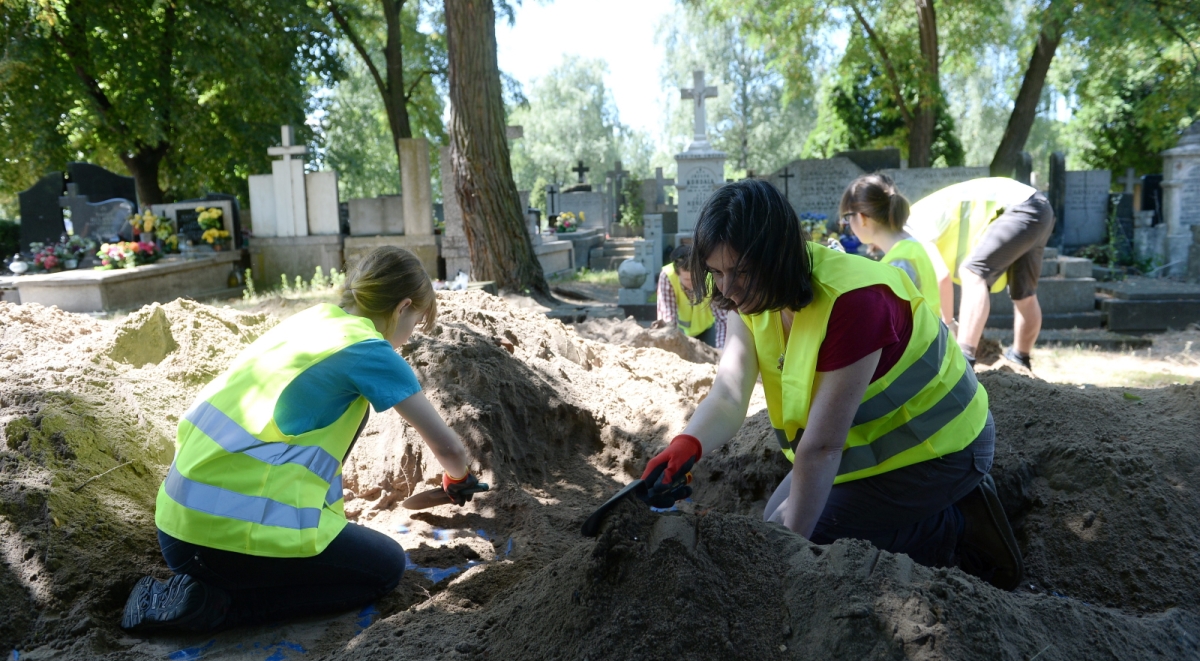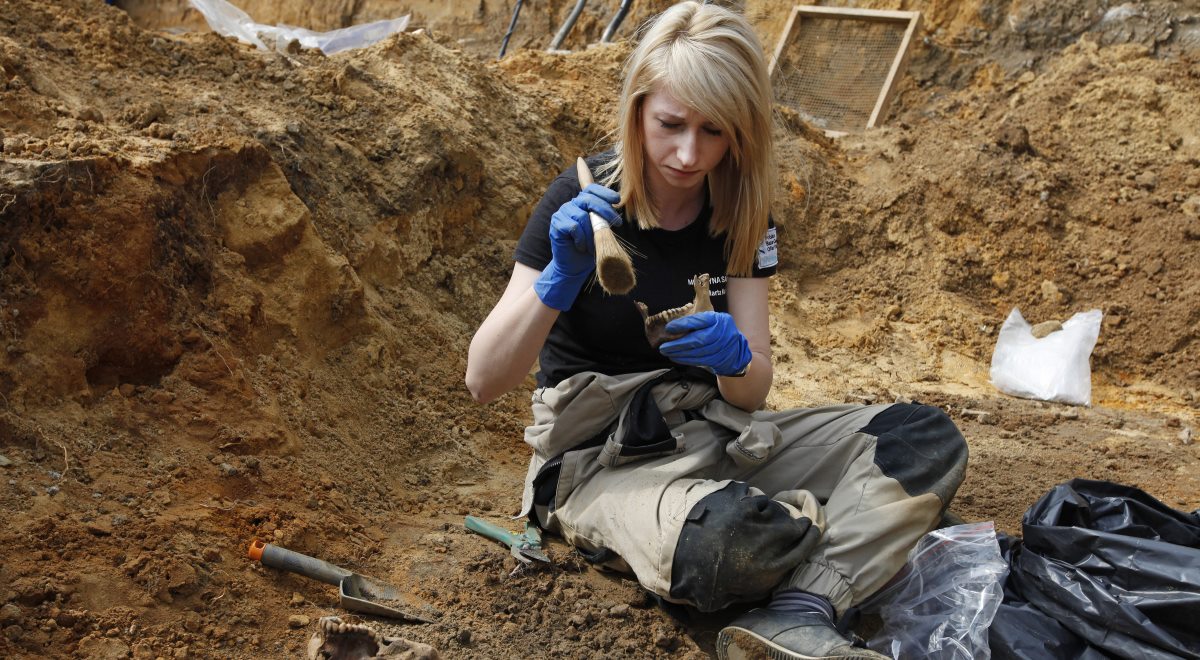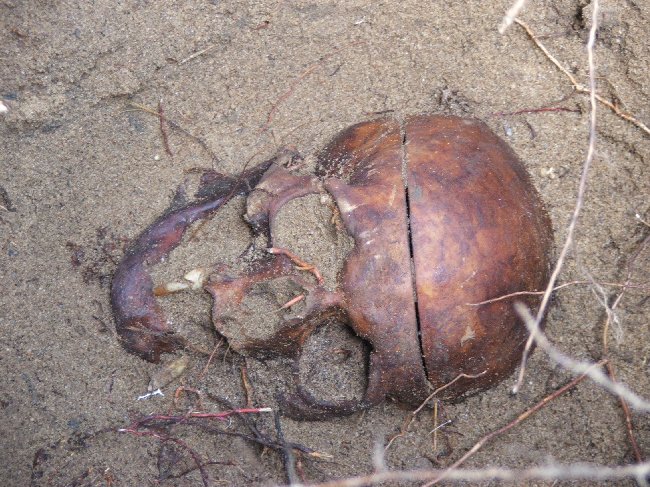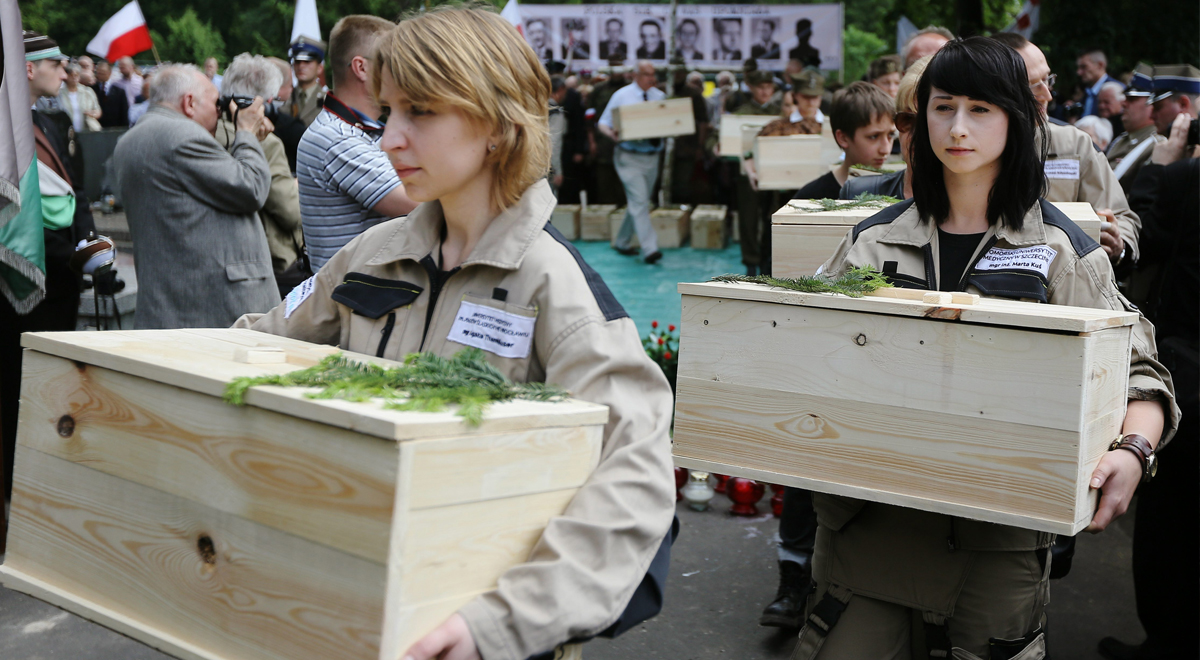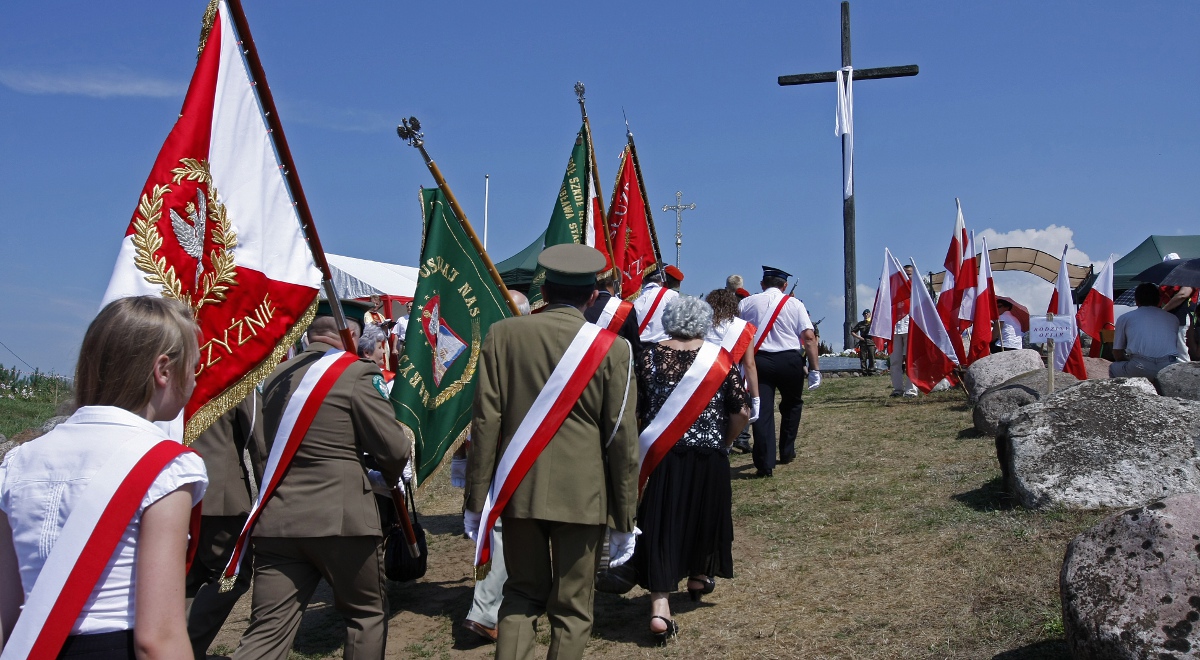|
|
Post by justjohn on Dec 6, 2015 12:48:29 GMT 1
Another execution site was found by Prof. Szwagrzyk’s team: Human remains discovered at former headquarters of the communist security police in Płock. Go here for more: www.doomedsoldiers.com/another-communist-execution-site-found-in-poland.html
Another execution site was found by Prof. Szwagrzyk’s team: Human remains discovered at former headquarters of the communist security police in Płock
Former headquarters of the PUBP (Polish Communist County Office for Public Security) in Płock is yet another site under the inspection of the IPN’s (Polish National Institute of Remembrance) historians and archaeologists’ team, led by prof. Krzysztof Szwagrzyk.
It took just a day for the experts to discover human remains buried in a shallow grave within close proximity to the secret police office building.
“The remains have been found disarranged, which suggests that the dead bodies were buried elsewhere and then transferred to this site at a later date,” says prof. Krzysztof Szwagrzyk. Other items such as fragments of shoes, spoons, etc., were also found. “All residents of Płock and neighboring areas know occupied the building during that time, as well as is ghastly history. After the war, the dreaded Polish UB (Security Office) took the building over from the German Gestapo. It is well known that people were murdered here during 1940s and 1950s, and that their bodies were never found. Some have speculated hat the bodies could have been buried in the area of the inner courtyard,” says Szwagrzyk.
Back in 1953, a detention centre was built just behind the PUBP office, and garages were added to the site in 1960s. The residents of Płock informed the historians that human remains were discovered when foundations for the garages were dug, only to disappear again. It is likely that the discovery of the prof. Szwagrzyk’s team is the very location to which those remains were moved.
The team will conclude its work shortly.
Source: wpolityce.pl
Translation: JD
Photo: www.wiadomosci24.pl |
|
|
|
Post by Bonobo on Dec 6, 2015 14:19:18 GMT 1
|
|
|
|
Post by Bonobo on May 27, 2017 21:34:35 GMT 1
69th anniversary of 'Auschwitz volunteer's' execution
25.05.2017 15:16
The wall where Poland's Witold Pilecki may have been executed has been unveiled at a former communist jail on the 69th anniversary of the so-called Auschwitz volunteer’s death.
Witold Pilecki. Photo: pilecki.ipn.gov.plWitold Pilecki. Photo: pilecki.ipn.gov.pl

The removal of plaster from the walls revealed bullet holes, which suggest it was an execution site at the Warsaw facility, where more than 300 anti-communist partisans were killed in the 1940s and 1950s. The site is now home to a museum.
Polish Justice Minister Zbigniew Ziobro said Pilecki may have been among those executed at the site.
Also marking the anniversary on Thursday, Pilecki’s daughter’s book, entitled “My Father”, was launched at the museum.
Witold Pilecki is known as the “Auschwitz volunteer” for allowing himself to be arrested by the Germans in 1940 and sent to Auschwitz in order to gain first-hand knowledge of the conditions there.
After escaping the Nazi German death camp in 1943, he shared his report with the Polish government-in-exile in London.
Also that year, Pilecki reached Warsaw and a year later fought in the Warsaw Uprising.
After the war, he went to Italy and joined the Second Corps.
He was sent by Polish intelligence to Poland on a mission. However, he was captured and executed by the communist authorities in 1948.
His burial place has never been found.
In 1990, he was rehabilitated, and in 2006 posthumously received the Order of the White Eagle, the highest Polish state distinction. He was posthumously promoted to the rank of colonel in 2013. (vb/pk)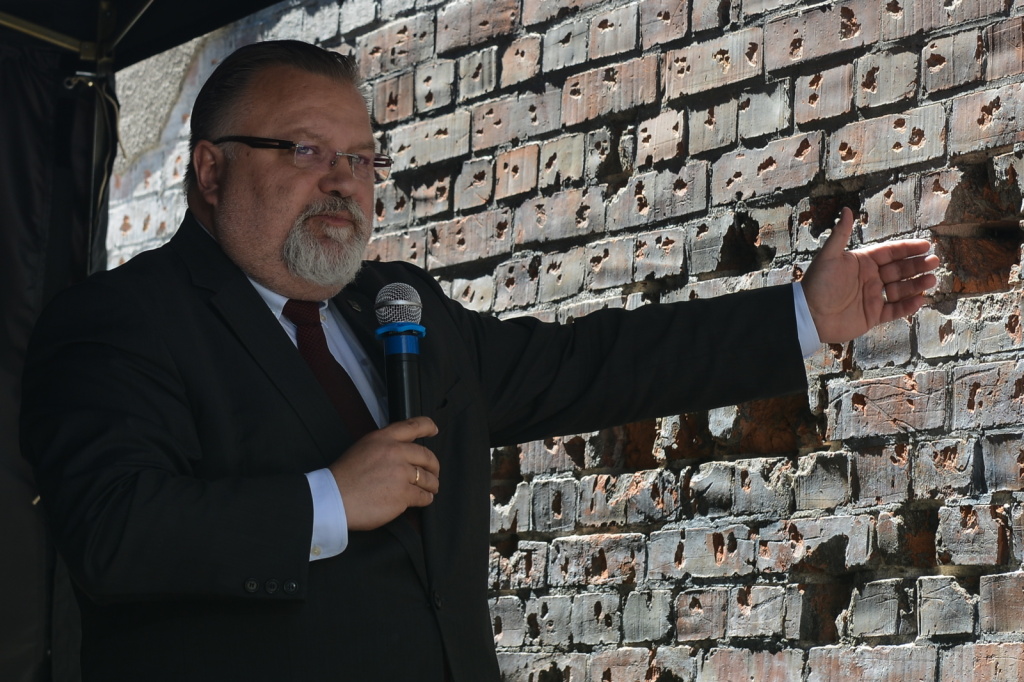  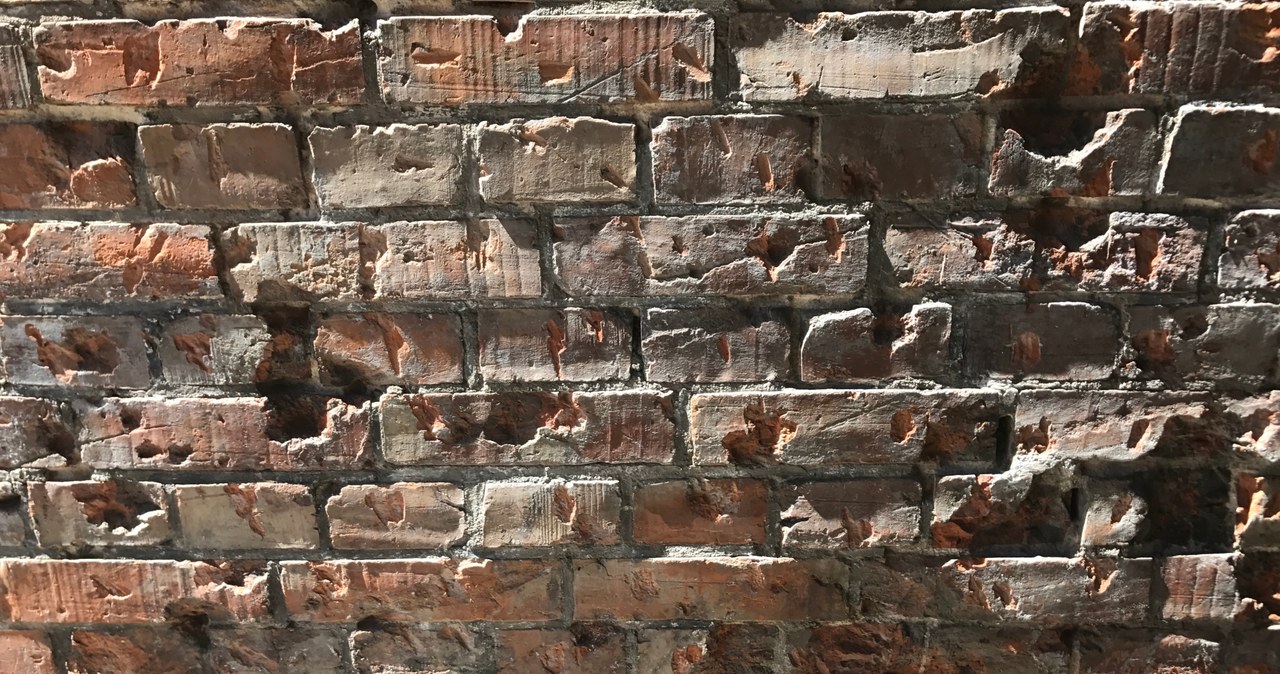
|
|
|
|
Post by Bonobo on Dec 25, 2021 20:02:46 GMT 1
The biggest burial site of communist terror victims is in the so caled Little Meadow in Warsaw. Here is the translation of pl.wikipedia.org/wiki/Kwatera_na_%C5%81%C4%85czce
Kwatera Ł, Kwatera na Łączce - the burial place at the cemetery wall of the Military Cemetery in Powązki in Warsaw, murdered by public security authorities [1] in the years 1945 - 1956 , often in the Mokotów prison . There is a Pantheon - the Mausoleum of the Accursed-Unbroken - in the Łęczna area .
Table of Contents
1 Places
2 Symbolic common grave
3 A celebration of memory, investigation
4 IPN exhumations
5 Foundation
6 Footnotes
7 Bibliography
8 External links
Places
The place where, from mid-1948 [2], the bodies of prisoners of the Mokotów prison were secretly hidden in the so-called The "lane" was located in the Powązki Cemetery, bordered by a common wall with the former Military Cemetery. On this site, a composting plant was set up, then a garbage dump, and in 1964 it was incorporated into the adjacent Military Cemetery, giving both parts - civil and military - the name: Communal Cemetery - Powązki [3] . Apart from the present quarters "Ł", formerly E (plan from 1971, opposite C27) (F, FII, FIII) [4], the sites of the former tombs are also located in the former quarters, under the present quarters M, MII and ŁII [5] .
The bodies of the murdered, who were symbolically buried in the "Na Łączce" Military Cemetery, were also hidden in other parts of Warsaw and its vicinity [6] [7] :
Służew: the old Służew cemetery at ul. Wałbrzyska extended with a plot previously owned by Józef Bokus [8] and an unspecified place in Służew nad Dolinka and generally in the parish of St. Catherine . Until mid-1948, the dead bodies tied in bags were transported "to Służew" for secret night burials by the gravedigger of the Mokotow Prison, Władysław Turczyński [9]
at the wall of the Horse Racing in Służewiec
The Bródno Cemetery in 45 N, which does not exist on the plans
at the prison wall of the Mokotów prison
the premises of the Prague Criminal Investigation Prison No. III, the so-called "Toledo" [10] at ul . 11 Listopada [11]
the war cemetery in Trojanów near Sochaczew [8] .
The symbolic common grave
Estimates based on the testimony of Alojzy Grabicki for the Commission Costirka show about 250 people buried directly in the headquarters of the Communal Cemetery. They are mainly military, often holding high positions in the Polish Army after the war, murdered by the so-called Military information mainly in the Mokotów prison.
People buried (symbolically) shown on the dismantled (due to the commencement of the exhumation works in this quarters in 2013) monument: ( The spaces correspond to the rows on the monument's plaque )
width = "50%" valign = "top"
Capt. Stefan Głogowski "Józef" 1910–1948
Capt. Józef Czerniawski 1896–1946
second-lieutenant Stefan Nowaczek "The Wolf" 1919-1946
Bolesław Panek 1923-1946
Edward Grabarz 1925-1946
second-lieutenant Zygmunt Szymanowski "Lis" 1910-1950
second-lieutenant Zygmunt Kęska "Świt" 1917–1946
Tadeusz Przybylski 1920–1951
Fr. second-lieutenant Kazimierz Łuszczyński 1922-1946
Edward Długosz "Kronikarz" 1918-1952
Ksawery Grocholski "Leonard" 1903–1947
Wiktor Komorowski 1926-1954
Bolesław Wasiutyński 1898–1951
Andrzej Wlekliński 1922–1948
Tadeusz Kościółek 1932-1953
Eugeniusz Chudowolski 1925–1951
Henryk Żmudzki 1900–1945
Lechosław Roszkowski 1910–1948
Tadeusz Łabędzki 1917–1946
Tadeusz Cieśla "Żbik" 1919-1952
second-lieutenant Jan Lebedowicz "Szeliga" 1897–1951
Tomasz Malczewski 1906–1945
Col. Antoni Wereszczyński 1890-1952
Helena Trzcińska (1909–1947)
Władysław Borowiec 1916–1948
Stefan Głowacki "Smuga" 1903–1949
Antoni Siwiec (1907–1952)
chor. Adolf Kaczmarczyk "Grom" 1905-1947
Stefan Skrzyszowski 1911–1953
Lech Rajchel "Lesław" 1929–1954
Tadeusz Polesiński 1918-1946
Augustyn Kania 1919-1954
Józef Marcinkowski "Wybój" 1900-1952
Zygmunt Urbanski 1919–1946
Piotr Bańczyk 1906-1952
Henryk Gosik 1923-1951
Józef Boguszewski 1916-1951
Leszek Śliwiński 1931–1953
Capt. Zygmunt Wolanin 1914–1946
Władysław Dubielak 1924–1955
Julian Łabędzki 1921–1951
Franciszek Krawczykowski 1906-1952
Emil Jabłoński "Salomon" 1895–1949
Leon Knyrewicz 1924–1947
Ryszard Kuzubski 1929-1952
Stefan Majewski 1910-1951
Bolesław Dominik 1918-1946
Wacław Rogala 1925-1946
Wiesław Płoński 1924-1946
Ryszard Widelski 1913–1949
Stanisław Derkus 1925-1951
Jan Bielski (1924–1952)
Major Zygmunt Roguski 1886–1946
Major Bolesław Lipski "Bartłomiej" 1890-1945
Jan Czeredys 1912–1948
Feliks Stroiński 1899–1948
Wacław Korwel 1914-1952
Józef Wołyniec 1917–1949
Piotr Stachowicz 1923-1951
Bogusław Pietrkiewicz 1930–1953
Stefan Bronarski 1916-1951
Władysław Kwiatkowski 1921–1951
Edmund Zakrzewski 1909–1946
Zygmunt Tutkaj 1922–1945
Edward Dziewa 1925-1951
Capt. Tadeusz Zawadziński "Wojciech" 1918-1948
Roman Jaroszyński 1916-1946
Eugeniusz Smoliński 1905–1949
Tadeusz Głuchowski 1923-1952
Tadeusz Dziońsko 1928-1953
Marian Kaczmarek (1904–1953)
Franciszek Michalski 1908–1953
Major Grzegorz Doliwa Dobrowolski 1898–1952
Dionizy Sosnowski 1929–1953
Zygmunt Jakimiuk 1916–1946
Roman Henryk Pawłowski "Orłow" 1925-1949
Władysław Stępnowski 1904–1950
Aleksander Wzorek 1929–1951
Wiktor Stryjewski 1916–1951
Zbigniew Bernatowicz 1924–1949
Stefan Tomaszewski 1897–1952
Jerzy Wierzbicki 1925-1951
Karol Rakoczy 1928-1950
Witold Bikulicz 1927-1952
Zdzisław Eichler 1908–1948
Jan Kuzko 1929-1953
Edward Bartkowski 1924-1946
Wacław Walicki "Teresa" 1903–1949
Jan Kruk "Tadeusz" 189? –1954
Stanisław Kopik "Revenge" 1914–1948
Edwin Matecki 1916-1946
Stanisław Karwowski (1918–1946)
Wincenty Morawski 1931–1951
second-lieutenant Zygmunt Wilczyński "Żuk" 1910-1950
Tadeusz Bejt 1923-1949
Stanisław Okniński 1923-1952
Franciszek Wyżykiewicz 1923-1946
Paweł Grieger 1918-1952
Telesfor Grewling 1932-1952
Henryk Borkowski 1913-1951
Stanisław Żabicki (1925–1952)
Jan Koj 1925-1952
Wincenty Paszuk 1925-1946
Zygmunt Woszczyński 1926–1953
Jerzy Zakulski 1911–1947
Tadeusz Gałka 1920–1950
prof. Władysław Tarnawski 1885–1951
Zygmunt Maciejec 1911–1947
Lieutenant Bodgan Olszewski 1917–1946
Paweł Pałys 1896–1953
Wiktor Kuczyński 1903–1950
Col. Jerzy Bronski 1903-1950
Ryszard Cieślak (1926–1958)
Napoleon Idzikowski 1924–1955
Jan Farbotnik 1919–1953
Mikołaj Łutczak 1924–1951
Capt. Aleksander Tomaszewski "Bończa" 1904–1949
Włodzimierz Miączuński 1923–1951
Lt. Col. Edward Pisula "Tama" 1898-1945
Brig. Gen. August Emil Fieldorf "Nil" 1895–1953
Col. Bernard Adamecki 1897-1952
Lt. Col. Zdzisław Barbasiewicz 1909-1952
Lt. Col. Stanisław Michowski 1900-1952
Lt. Col. Aleksander Kita 1912-1952
Col. Marian Orlik 1916-1953
Fr. Rudolf Marszałek 1911–1948
Władysław Dybowski (1892–1947)
Mieczysław Kawalec "Żbik" 1931–1953
Julian Czerwiakowski 1911–1953
Mirosław Nowicki 1904–1948
Major Józef Rzepka "Krzysztof" 1913-1951
Maj. Karol Jabłoński 1903–1953
Apolinary Rybicki 1903–1947
width Tadeusz Mroczkowski 1924–1946
Cdr. Stanisław Mieszkowski 1903–1952
Cdr. Jerzy Staniewicz 1903–1952
Cdr. Lieutenant Zbigniew Przybyszewski 1907–1952
colonel obs. Józef Maksymilian Jungrav 1897–1952
Col. August Menczak 1894-1952
Col. Władysław Minakowski 1902-1952 pilot
Lt. Col. Roman Rypson 1899-1953
Col. Pilot Obs. Szczepan Ścibior 1903–1952
Capt. Franciszek Błażej 1907–1951
Lt. Col. Kazimierz Gąsiorowski "Edyta" 1903-1952
Władysław Lisiecki 1919–1952
Konrad Dybowski 1919–1947
Lieutenant Edward Nowicki 1910-1945
Major Ludwik Świder 1893–1952
Capt. Wacław Alchimowicz 1914–1948
Col. Aleksander Rode 1909-1953
Col. Zygmunt Bohdan Sokołowski 1908–1953
Col. Feliks Michałkowski 1907-1953
Major Zefiryn Machalla 1915-1952
Major Benno Zerbst 1923-1953
Lt. Col. Lucjan Szymański "Janczar" 1897-1945
Major Stanisław Tabisz 1888–1948
second-lieutenant pilot Edward Pytko 1929-1952
Zdzisław Klimpel 1902–1949
Capt. bow. med. Witold Karlicki "Marian II" 1910-1947
Lieutenant Arkadiusz Wasilewski "Biały" 1925-1949
prof. Marian Grzybowski (1895–1949)
Lieutenant Roman Gronski "Żbik" 1926-1948
Capt. Stanisław Łukasik "Ryś" 1918-1949
Capt. Józef Batory 1914-1951
Brig. Gen. Franciszek Kwiryn Herman 1904–1952
Col. Aleksander Krzyżanowski "gen. Wilk ”1898–1951
Lt. Col. Antoni Olechnowicz "Pohorecki" 1905-1951
Lt. Col. Łukasz Ciepliński 1913-1951
Major Bolesław Kontrym "Żmudzin" 1898–1953
Major Hieronim Dekutowski "Zapora" 1918-1949
Col. Zygmunt Szendzielarz "Łupaszko" 1910-1951
Capt. Jan Morawiec "Remisz" 1915–1948
Lieutenant Konstanty Kociszewski "Górka" 1905-1946
Major Andrzej Rudolf Czaykowski "Garda" 1912-1953
second-lieutenant Roman Rawicz Karwowski 1908–1946
Capt. Gracjan Fróg "Szczerbiec" 1911–1951
Waldemar Baczak "Arnie" 1922–1947
Lech Neyman 1908–1948
Feliks Antczak 1916–1945
rtm. Witold Pilecki 1901–1948
Włodzimierz Marszewski "Gorczyca" 1891–1948
Lt. Col. Stanisław Kasznica 1908-1948
Major Adam Lazarowicz 1902-1951
Maj Karol Sęk 1893-1952
Capt. Adam Mirecki 1909-1952
Capt. Bronisław Chajęcki 1902–1952
Lieutenant Jan Wyszomirski 1913–1945
second-lieutenant Zbigniew Romer 1917-1952
cpr. Stefan Pietusiński 1929–1953
Lieutenant Jan Przybyłowski 1917–1951
Lieutenant Mieczysław Sokołowski "Dakowski" 1910-1947
second-lieutenant infantry reserve Stefan Górski "Brzeg" 1922–1948
Jerzy Stolarski 1921-1950
Fr. Zygmunt Kaczyński 1894–1953
Jan Rodowicz "Anoda" 1923-1949
Col. Mieczysław Oborski 1900-1953
Jerzy Jętkiewicz 1925-1953
Jerzy Miatkowski "Zawada" 1923-1949
Lieutenant Edmund Tudruj "Mundek" 1923–1949
Lieutenant Karol Chmiel 1911-1951
Adam Gajdek "Olek" 1915-1949
Zygmunt Ojrzyński "J 13" 1903–1953
Józef Krasowski 1901–1946
Bolesław Połścik 1924–1951
Lieutenant Edmund Rosochacki 1920–1952
second-lieutenant Zygmunt Lercel 1921–1950
Helena Żurowska 1905-1949
Tadeusz Pelak "Junak" 1922-1949
Capt. Antoni Błaszczyński 1903–1951
Stanisław Stankiewicz 1903–1947
Leon Dziubecki 1904–1948
Stanisław Piwek 1900-1948
Adam Doboszyński 1904–1949
Jan Kaim 1912-1949
Edmund Bukowski 1918-1950
Tadeusz Klukowski 1931–1953
Zbigniew Ejme 1912–1953
Mieczysław Gągorowski 1922–1952
Stanisław Mieraelński 1922–1949
Lucjan Minkiewicz "Wiktor" 1918-1951
Major Józef Gumowski "Ziutek" 1916-1952
Tadeusz Leśnikowski 1916-1950
Sgt. Józef Bahrycz 1925-1952
Stanisław Mittlener-Dąbrowa 1897–1953
Leopold Rutkowski 1887–1949
Eugeniusz Falkus 1931–1952
Władysław Śliwiński 1921–1951
Edmund Pawliszewski 1912-1949
Marian Szymczak 1920–1955
Lt. Col. Stefan Długołęcki 1906–1948
Władysław Ulanowski 1921–1948
Jan Wardak "Złiciel" 1916–1945
Jerzy Leopold Stiasny 1919–1946
Władysław Żwirek 1911–1946
Kazimierz Wojciechowski 1900-1945
Stanisław Kaczmarczyk 1922-1946
Stanisław Zalewski 1913-1947
Jan Piesiewicz 1902–1952
Stefan Ostrowski "Szczygieł" 1917–1945
Kazimierz Tuszyński "Łoś II" 1924-1950
Commemorating Remembrance, Investigations
In the above-mentioned places, the families of the murdered would secretly lay flowers. After 1956, some SB officers informally indicated places to the families of the victims [12] .
In 1956, the case of secret burials was investigated by the deputy of the Public Prosecutor General of the People's Republic of Poland and a member of the Polish United Workers' Party, Kazimierz Koszirko , who stated in his protocol there was no prison documentation indicating who was buried. The members of the commission drawing up the report were also Lt. Col. Marian Frenkiel - the then chief of the III. Branch of the Supreme Military Prosecutor's Office , accused of participating in the murders, and Jan Barczak - deputy director of the Central Board of Prisons. Costirka's report was also signed by the gravedigger Władysław Turczyński (the brother of Second Lieutenant Kazimierz Turczyński , who participated in the investigation against Commander Mieszkowski, killed and buried in "Łączka", among others [13] ).
Until martial law, the families looked after the place in the cemetery. During the martial law period, the area was leveled and earmarked for new graves, mainly military. For example, the grave of Jerzy Wenelczyk, the former torturer of Commander Mieszkowski, who was buried at that time, is located near the supposed burial site of his victim [14] .
In March 1988, journalist Małgorzata Szejnert started her own investigation to determine the actual places of burial [15] . In October 1989, the Ministry of Justice published the work undertaken by the Central Board of Penal Institutions on the complete list of people executed in PRL prisons in the years 1945–1956 and informed about the discovery of the Costirka Report [8] . The team developing the list also did not find any documentation of the burial places [16] .
On January 10, 1990, the Social Committee for the construction of the monument was established, chaired by the wife of one of the executed, lawyer Maria Romer-Kędzierska [17] . The foundation stone for the monument was laid on November 1, 1990. The author of the project is arch. Dominik Mączyński. The monument in the shape of a fragment of a brick wall with the letter "V" cut out was built in 1991.
The monument with the letter "V" was demolished in connection with the commencement of exhumation works in 2013.
On September 27, 2015, the Pantheon - Mausoleum of the Cursed-Unbreakable, designed by the sculptor Jan Kuka and architect Michał Dąbek from Krakow , was unveiled in the "Ł" section . On the day of its unveiling, the remains of the first 35 exhumed and identified victims were buried there.
IPN exhumations
The graves of Lieutenant Stefan Głowacki pseud. "Smuga" and major Bolesław Kontrym pseud. "Żmudzin" on the day of the funeral in the Pantheon - Mausoleum of the Cursed-Unbroken at the Powązki Military Cemetery in Warsaw (27/09/2015)
Institute of National Remembrance , Council for the Protection of Memory of Combat and Martyrdom and the Ministry of Justice in cooperation with the Capital City of Warsaw In the years 2012–2013, Warsaw carried out a research project entitled "Searching for unknown burial places of victims of communist terror from 1944–1956". The exhumations led by Krzysztof Szwagrzyk began on July 23, 2012, and on July 24, the assumptions about the mass graves of the victims of communist crimes in the years 1944–1956 were confirmed [18] . During the works carried out in July and August 2012, the remains of 117 people were excavated; further works are planned in Powązki in April 2013, and in Służewo in September 2013. It is estimated that up to 300 people found their burial in Łączka [19]. The excavated remains were subjected to DNA testing at the initiative of the Pomeranian Medical University in Szczecin, using genetic data collected in the Polish Genetic Database of Victims of Totalitarianism [20] .
On December 6, 2012, the Institute of National Remembrance and the Council for the Protection of Remembrance, Struggle and Martyrdom together with the Pomeranian Medical University in Szczecin announced that the identities of the remains of the first three victims had been identified: Edmund Bukowski , Stanisław Łukasik and Eugeniusz Smoliński [21] . On February 20, 2013, the names of the next victims were announced, including: Stanisław Abramowski , Bolesław Budelewski , Stanisław Kasznica and Tadeusz Pelak . On February 28, 2014, a ceremony was held in Belweder Palace with the participation of President Bronisław Komorowski, during which 12 more names of identified victims were announced [22] . June 9, 2016In the Presidential Palace in Warsaw , the families were handed more identification cards. Among those identified were: Bronisław Chajęcki , Zygmunt Jezierski , Jan Kaim , Czesław Kania , Stanisław Konczyński , Stefan Skrzyszowski and Jerzy Staniewicz [23] .
In connection with the extraction of all the remains that were in the Ł II quarter, the exhumations were completed in July 2017 [24]. Identification of over a thousand bones found in total out of an estimated three hundred people requires longer work.
People whose remains have been identified so far with the help of the Polish Genetic Database for Victims of Totalitarianism [25]  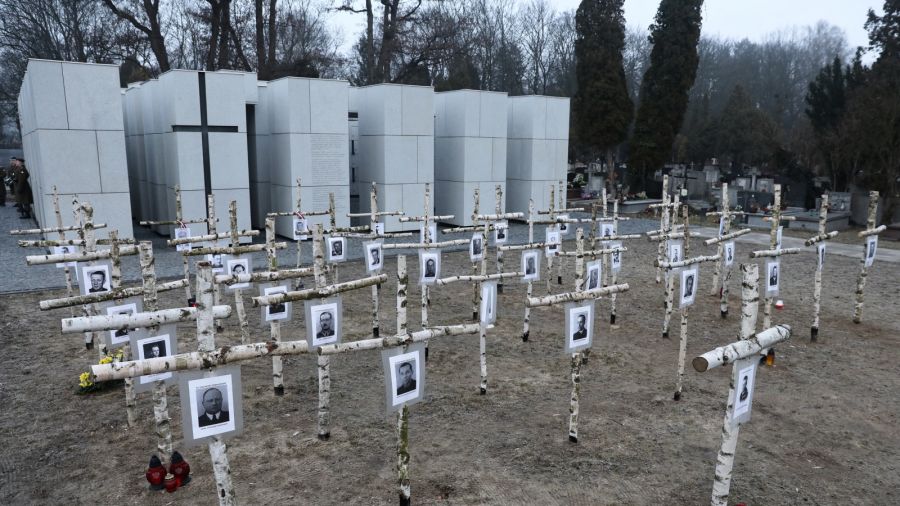 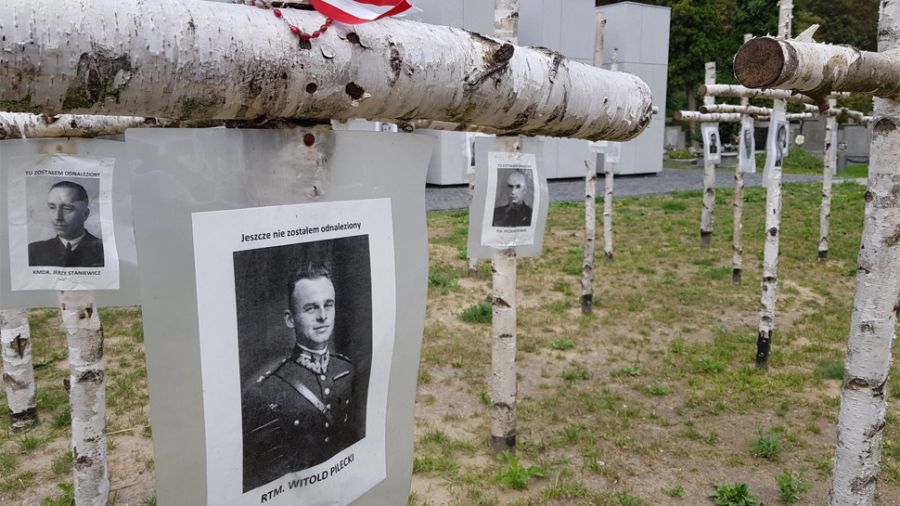  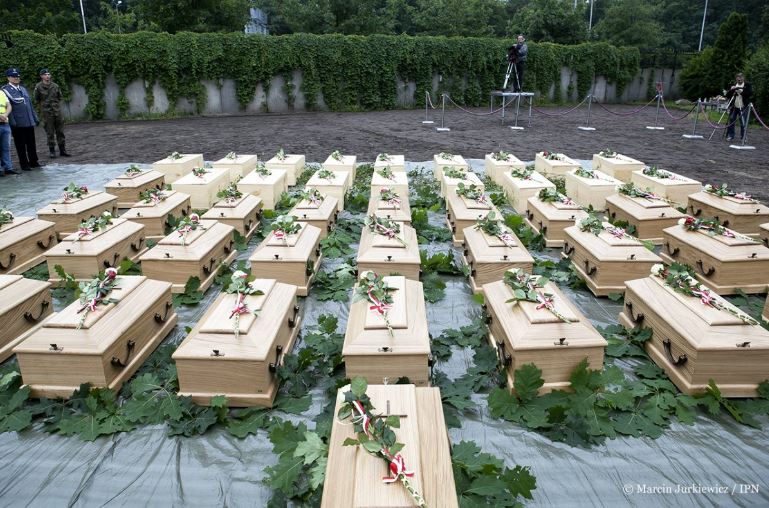  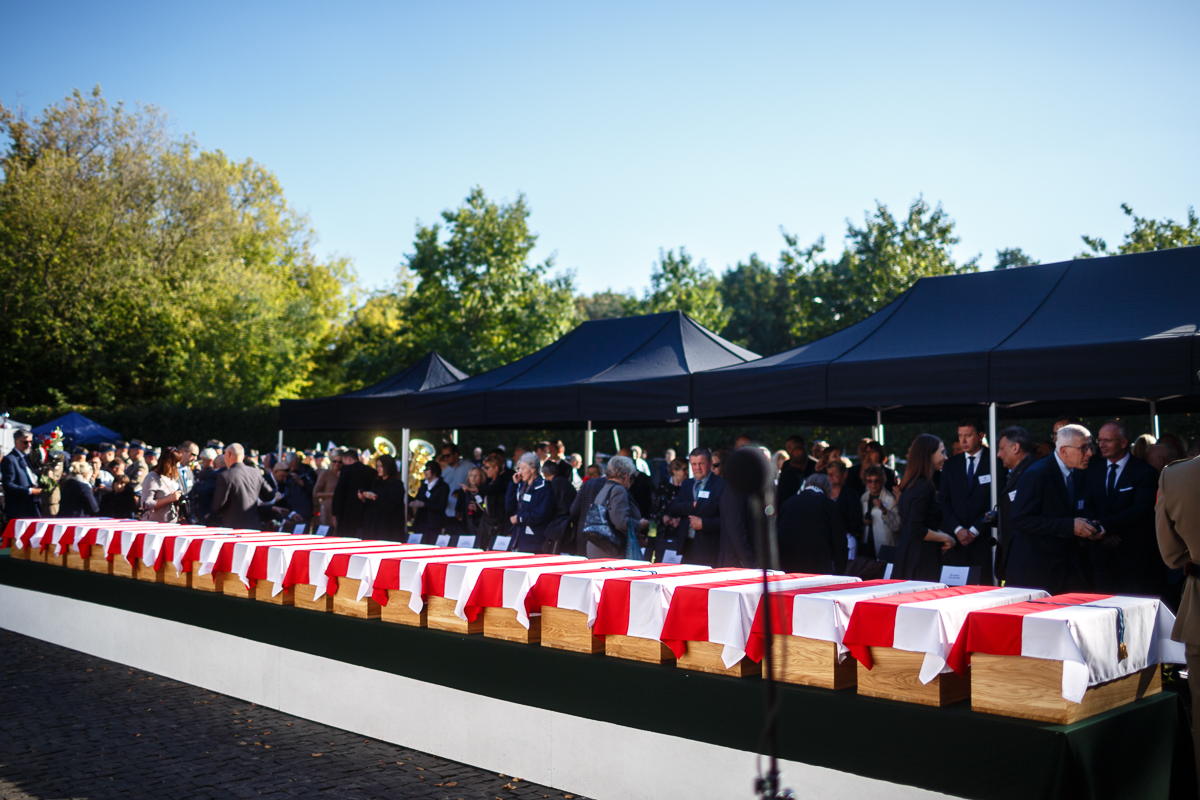 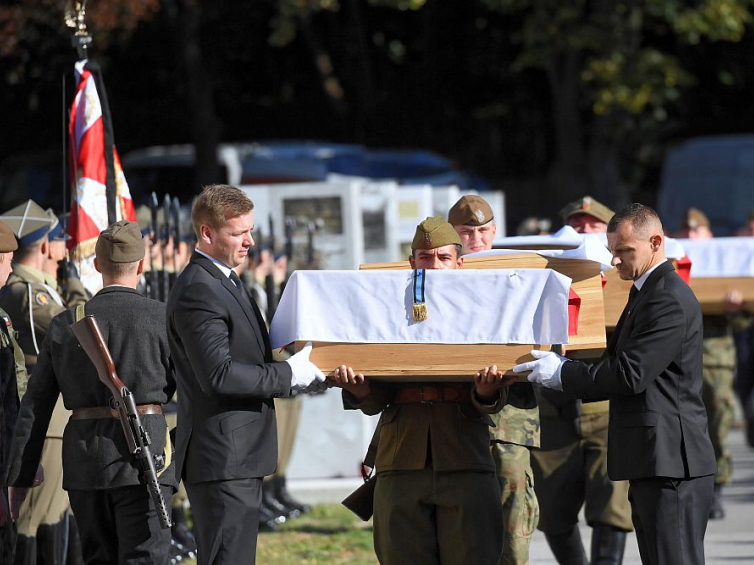 |
|













